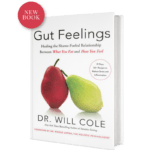Navigating The SIBO Diet: What To Have + What To Avoid

I remember a time in the not-so-distant past when the idea of the gut influencing every single aspect of our health seemed radical to a lot of people. Now, the importance of gut health is part of our collective consciousness more than ever.
This increased interest in gut health, while necessary and positive, has also brought with it an avalanche of choice and information. New gut healing supplements, diets, and protocols are coming at us from all angles, leaving many people confused and overwhelmed.
I hear this all the time in my functional medicine practice. Patients say “I know I need to heal my gut, and I know that my diet is important, but I can’t figure out what I really should and shouldn’t eat.”
This is especially true when it comes to patients with SIBO. Why? In part, because many of them are already eating clean, healthy diets, and not getting any better. There’s a reason for this, and I’ll get to it below.
Here, I’ll break down and simplify everything you need to know about implementing and navigating a SIBO diet.
If you’ve been diagnosed with SIBO or IBS, or if you’re experiencing symptoms like fatigue, bloating, gas, and constipation or diarrhea, read on to learn which foods to eat and avoid, and how to track and personalize your diet. I’ll also touch on the controversial question about probiotics and SIBO, and share how you can supercharge the effects of your gut healing diet.
SIBO And Your Gut Microbiome
Small intestinal bacterial overgrowth (SIBO) is exactly what it sounds like: an overgrowth of bacteria in the small intestine. This is one type of gut dysbiosis (an imbalance of bacteria and microorganisms in the gut microbiome).
In a healthy intestinal system, most of our gut bacteria lives in the large intestine, with a small amount also being found in the small intestine, and an even smaller amount in the stomach.
SIBO occurs when too much gut bacteria takes up residence in the small intestine. This can happen for various reasons, including structural problems in the intestine, low stomach acid, the use of certain medications, or, often, decreased function of the migrating motor complex (MMC) which is typically responsible for pushing bacteria down into the large intestine (1).
SIBO can cause a number of different digestive symptoms, as well as symptoms that don’t seem to relate to the gut (again, the gut profoundly influences our mental, emotional, and overall health).
Symptoms may include:
- Bloating
- Gas
- Fatigue
- Anxiety
- Brain fog
- Constipation
- Diarrhea
- Abdominal pain or cramping
- Heartburn, acid reflux, or GERD
- Nausea
Especially if left undetected, SIBO can also lead to complications like vitamin and nutrient deficiencies (excess bacteria in the small intestine will literally consume the nutrients that are meant for you), leaky gut syndrome, and the development of autoimmune conditions.
SIBO frequently overlaps with IBS (irritable bowel syndrome), and in many cases, is thought to be the cause (2).
How Diet Can Help
Diet is one of the most important factors when it comes to healing from any condition, and SIBO is definitely no exception.
SIBO is often treated with prescription antibiotics. This can be effective, especially in the short term: you’re basically sending in a powerful agent to wipe out as much overgrown bacteria as possible.
But in my experience this is, at best, an incomplete strategy. Without addressing the underlying cause of SIBO, it’s likely that the overgrowth will simply return, and we certainly don’t want to be continuing to take antibiotics over the long term (they can wreak their own havoc on the body).
Antibiotics are also generally indiscriminate, and may kill off too much of the beneficial bacteria throughout the gut that helps keep us healthy.
A well-rounded SIBO strategy, whether or not it includes antibiotics, prioritizes diet as a powerful, holistic tool that supports more thorough gut healing.
There isn’t necessarily one specific SIBO diet that works for everyone, but there are a few solid options out there.
The Low FODMAP Diet for SIBO
The most popular, and likely most widely effective, SIBO diet is the low FODMAP diet. FODMAP stands for Fermentable Oligosaccharides, Disaccharides, Monosaccharides, and Polyols. Essentially, this is a group of carbohydrates and sugars found in certain foods that resist digestion and are instead consumed and fermented by gut bacteria.
In a healthy gut, this is fine (and can be beneficial). The problem when it comes to SIBO is that bacteria feed off of these FODMAPs. So, if we have excess bacteria in the small intestine, and we are consuming high FODMAP foods, we are basically feeding these excess bacteria and helping them to proliferate.
A low FODMAP diet involves temporarily restricting these high FODMAP foods, with the intention of starving overgrown bacteria.
Most of the published research on the low FODMAP diet looks at individuals with IBS, and is very positive (3). Up to 86% of those with IBS have been shown to have improved symptoms when following a low FODMAP diet (4).
There isn’t much research on the low FODMAP diet for SIBO– mostly because at this stage, there still isn’t much research on SIBO, a relatively newly understood form of dysbiosis, in comparison with IBS, a widely recognized syndrome thought to affect up to 15% of the US population.
But, studies have shown that a significant proportion of those with SIBO also have IBS, and vice versa (5). In fact, it’s often thought that SIBO is the most common underlying cause of IBS (which is characterized by chronic digestive symptoms).
Clinically, the low FODMAP diet is very commonly used for SIBO cases, and often with great results.
There are a few other options that may work for some, including the specific carbohydrate diet (SCD) and Dr. Allison Siebecker’s SIBO Specific Diet. I’ve also seen a number of patients have success with a low histamine diet, as histamine intolerance and SIBO are often related.
In most cases though, I would start with a foundation of clean eating, and move on to a trial of a low FODMAP diet next. If it doesn’t seem to be effective for you, then you may want to explore some of the other options I mentioned above.
Food And Drinks To Include
The first thing I’ll say about the low FODMAP diet list, just to get it out of the way, is that it’s not intuitive. And that’s okay. There are some great guides and apps out there to help you keep track of which foods are high and low FODMAP. I highly recommend all of the tools put out by Monash University, a leading FODMAP research institution, including their app.
Here are some of the foods you can include and enjoy on a low FODMAP diet for SIBO:
- Protein sources: Eggs, fish, poultry, beef (choose organic where possible)
- Certain vegetables: Carrots, cucumber, zucchini, potatoes, bok choy, green beans, eggplant, green bell pepper, lettuce
- Certain fruits: Grapes, oranges, pineapple, cantaloupe, kiwi, tomatoes
- Some nuts and seeds: Walnuts, pumpkin seeds
- Milk alternatives: Almond milk, lactose-free milk
- Certain grains: Rice, quinoa, oats
Food + Beverages To Avoid
If you’ve ever had the experience of eating a beautiful, nutritious, vegetable filled meal only to then have your symptoms flare up, that’s a pretty good sign that you could have SIBO or a FODMAP intolerance.
As seen above, some fruits, vegetables, and other foods commonly understood to be healthy are great on a low FODMAP diet. But others fall into the high FODMAP category, and should be at least temporarily avoided on your SIBO diet.
Here are some of the foods to avoid on a low FODMAP diet for SIBO:
- Certain vegetables: Asparagus, artichokes, cauliflower, mushrooms, peas
- Garlic and onions
- Certain fruits: Apples, cherries, peaches, pears, plums, watermelon, mango
- Legumes: Beans, lentils
- Certain nuts and seeds: Pistachios, cashews
- Dairy products: Cow’s milk, yogurt, milk products
- Some grains: Wheat, rye (including breads, crackers, cereals)
- Sugar alcohols and sweeteners: Sorbitol, xylitol, erythritol
FODMAPs aside, I would also highly recommend limiting processed foods, industrialized seed oils, sugar, and alcohol, especially when looking to heal your gut.
Probiotics For SIBO: Yes Or No?
Should you add probiotics to your treatment plan for SIBO? This is a good question, and one that I get a lot. Probiotics (supplemental good bacteria) are among the most broadly effective and beneficial gut supports out there.
But there’s disagreement in the functional medicine field (and in general) about whether they may actually be problematic for those with SIBO. Why? Well, SIBO isn’t necessarily an overgrowth of “bad” bacteria. Even beneficial bacteria, when overabundant in the small intestine, is an issue. The problem is excess, somewhat regardless of species. So, some people have concerns around introducing more bacteria into the mix.
However, I find that for most people with SIBO, probiotics are helpful, especially when combined with herbal antimicrobials. There are some exceptions, so you’ll want to monitor how you feel if you do choose to introduce one.
But probiotics play a lot of roles in the gut. Some of them even have antimicrobial effects, in the sense that they have the ability to kill off bad bacteria. And studies pretty consistently find that they’re effective for IBS (6), which, again, massively overlaps with SIBO.
In our clinic, we’ve seen particularly good results with spore-based (soil-based) probiotics.
LISTEN: How FODMAP Intolerance & SIBO Hurt Our Mood & Gut Health + What To Do About It | Dr. Will Cole
When You’ll Notice Improvement
The low FODMAP diet for SIBO is fairly restrictive, and it’s not meant to go on forever. So how long can you expect it to take before you see improvements?
This really is an individual question, but here are a few things to keep in mind.
First, the low FODMAP diet should generally be treated as an elimination diet. The low FODMAP diet is not intended to be followed long term.
You’ll work through three general phases:
Elimination phase: This is when you will follow the diet as closely and strictly as possible. How long to stay in this phase is one of the big individual questions around the low FODMAP diet. If you’re generally healthy and experimenting with the diet to see if you may be able to fine-tune some of your sensitivities, 2-3 weeks may be sufficient. Many people recommend 2-6 weeks in general for the elimination phase of a low FODMAP diet. But if you’ve been struggling with SIBO for some time, you may need more time here – possibly several months to a year or longer.
Reintroduction phase: Once you’ve reached a plateau with the benefits of the diet, you’ll move on to the reintroduction phase, during which you’ll reintroduce individual foods, one at a time, and monitor how you feel. It’s generally best to reintroduce just one food every 2-3 days, so that you can really observe how each one makes you feel. During this phase, you will likely be able to identify that some higher FODMAP foods trigger your SIBO symptoms, while others are totally fine.
Personalization phase: Based on what you learned in the reintroduction phase, you can now start to fine tune your long term eating plan, aiming to avoid the foods that you found triggering and include the whole foods that your body responded well to.
If you don’t notice any improvements after your first month or two on your SIBO diet, you may want to try a different diet, or work with your practitioner on incorporating different strategies into your healing protocol.
As important and powerful as diet can be, when it comes to SIBO, it is likely not enough on its own. For the best and most sustainable results, you’ll want to simultaneously work on healing your gut with the help of other tools like probiotics, herbal antimicrobials (7), and mind-body practices. Many people also find benefit from doing a short term elemental diet (a pre-digested meal replacement formula that gives your gut a break in order to heal) (8).
Your Journey To Healing Doesn’t Have To Be Walked Alone
Navigating SIBO, from choosing your diet and supplements to deciding whether or not to take antibiotics, is a personal journey. But that doesn’t mean you have to go it alone. At our functional medicine clinic, we have many years of experience working with SIBO cases, and we would love to help you heal your gut and feel your best. You can get started with a telehealth consultation here.
Symptoms of SIBO can include digestive symptoms like bloating, gas, diarrhea, constipation, abdominal pain, nausea, or acid reflux, as well as more general symptoms like fatigue, anxiety, and brain fog.
The low FODMAP diet is intended to be a short-term diet to starve overgrown bacteria, reduce inflammation and symptoms of SIBO, IBS, or similar conditions, and help heal and rebalance the gut microbiome. However, it may not be best for everyone as a long term diet.
Start Your Health Journey Today
FUNCTIONAL MEDICINE CONSULTATIONS FOR PEOPLE AROUND THE WORLD
- Sorathia SJ, Chippa V, Rivas JM. Small Intestinal Bacterial Overgrowth. [Updated 2023 Apr 17]. In: StatPearls [Internet]. Treasure Island (FL): StatPearls Publishing; 2024 Jan-. Available from: https://www.ncbi.nlm.nih.gov/books/NBK546634/
- Takakura W, Pimentel M. Small Intestinal Bacterial Overgrowth and Irritable Bowel Syndrome - An Update. Front Psychiatry. 2020;11:664. Published 2020 Jul 10. doi:10.3389/fpsyt.2020.00664
- Altobelli E, Del Negro V, Angeletti PM, Latella G. Low-FODMAP Diet Improves Irritable Bowel Syndrome Symptoms: A Meta-Analysis. Nutrients. 2017;9(9):940. Published 2017 Aug 26. doi:10.3390/nu9090940
- Nanayakkara WS, Skidmore PM, O'Brien L, Wilkinson TJ, Gearry RB. Efficacy of the low FODMAP diet for treating irritable bowel syndrome: the evidence to date. Clin Exp Gastroenterol. 2016;9:131-142. Published 2016 Jun 17. doi:10.2147/CEG.S86798
- Ghoshal UC, Shukla R, Ghoshal U. Small Intestinal Bacterial Overgrowth and Irritable Bowel Syndrome: A Bridge between Functional Organic Dichotomy. Gut Liver. 2017;11(2):196-208. doi:10.5009/gnl16126
- Yang R, Jiang J, Ouyang J, Zhao Y, Xi B. Efficacy and safety of probiotics in irritable bowel syndrome: A systematic review and meta-analysis. Clin Nutr ESPEN. 2024;60:362-372. doi:10.1016/j.clnesp.2024.02.025
- Chedid V, Dhalla S, Clarke JO, et al. Herbal therapy is equivalent to rifaximin for the treatment of small intestinal bacterial overgrowth. Glob Adv Health Med. 2014;3(3):16-24. doi:10.7453/gahmj.2014.019
- Pimentel M, Constantino T, Kong Y, Bajwa M, Rezaei A, Park S. A 14-day elemental diet is highly effective in normalizing the lactulose breath test. Dig Dis Sci. 2004;49(1):73-77. doi:10.1023/b:ddas.0000011605.43979.e1
The information on this website has not been evaluated by the Food & Drug Administration or any other medical body. We do not aim to diagnose, treat, cure or prevent any illness or disease. Information is shared for educational purposes only. You must consult your doctor before acting on any content on this website, especially if you are pregnant, nursing, taking medication, or have a medical condition.
Our content may include products that have been independently chosen and recommended by Dr. Will Cole and our editors. If you purchase something mentioned in this article, we may earn a small commission.

BY DR. WILL COLE
Dr. Will Cole, DNM, IFMCP, DC is a leading functional medicine expert who consults people around the globe, starting one of the first functional medicine telehealth centers in the world. Named one of the top 50 functional and integrative doctors in the nation, Dr. Will Cole provides a functional medicine approach for thyroid issues, autoimmune conditions, hormonal imbalances, digestive disorders, and brain problems. He is also the host of the popular The Art of Being Well podcast and the New York Times bestselling author of Intuitive Fasting, Ketotarian, Gut Feelings, and The Inflammation Spectrum.

Gut Feelings
Healing The Shame-Fueled Relationship
Between What You Eat And How You Feel
